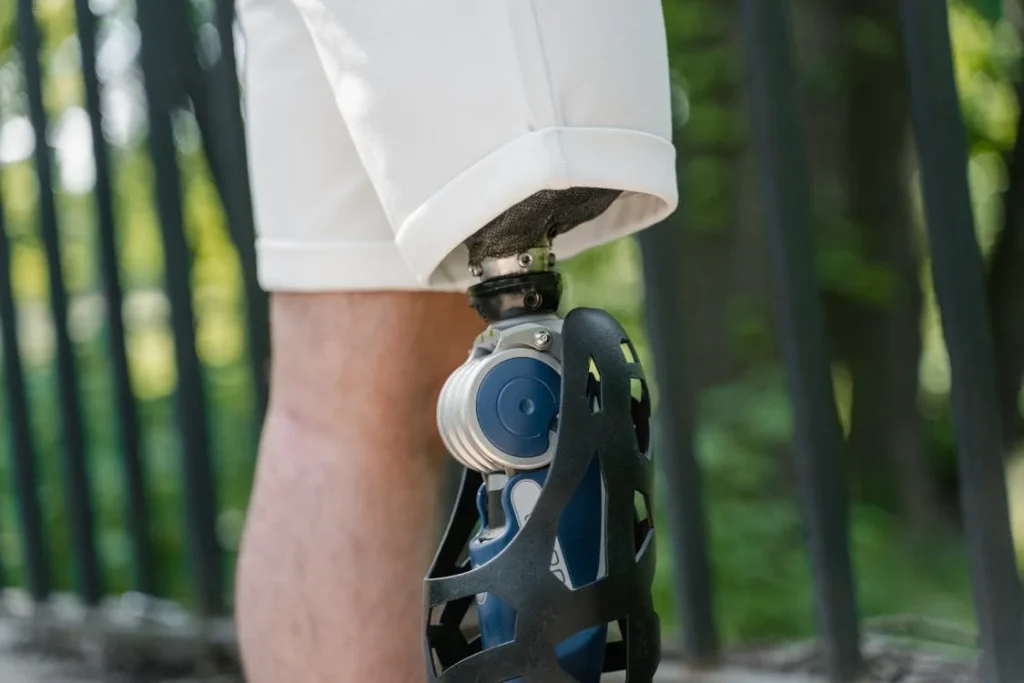Learning to walk again with a prosthetic leg is not just about muscles, joints, and sockets. It’s also about the brain. The way we move is deeply connected to how we see ourselves move. When someone loses a limb, that natural connection between mind and body can be disrupted. It can make walking feel awkward, unbalanced, or disconnected — even with a perfectly fitted prosthesis.
That’s where mirror therapy and visual feedback come in. These simple, powerful techniques help retrain the brain to work in harmony with the body again. They don’t just improve how you walk — they change how you feel while walking. They bring back a sense of control, confidence, and awareness that’s often lost after amputation.
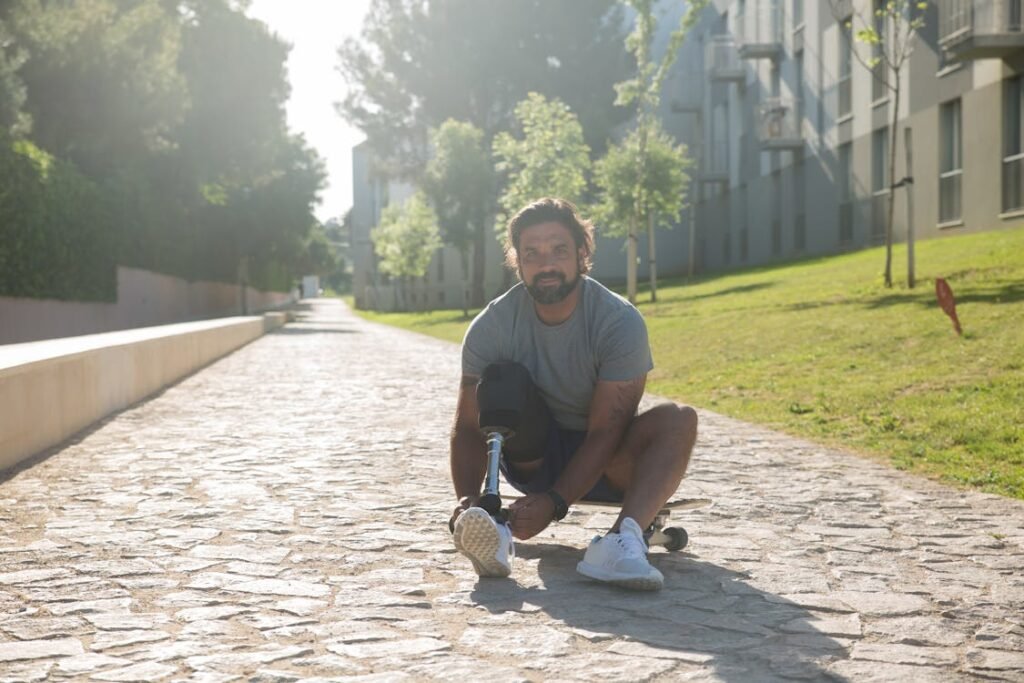
How the Brain and Body Work Together During Gait
The Hidden Role of the Brain in Every Step
Most people don’t realize how much the brain is involved in walking. We often think of walking as something automatic — something our legs just do. But in truth, every step we take starts in the brain. The brain plans the movement, sends signals to the muscles, adjusts balance in real time, and responds to what we see, feel, and hear.
When someone loses a leg and begins using a prosthetic limb, this brain-body connection changes. The limb doesn’t provide the same sensation. The muscles around the amputation site move differently. The visual input doesn’t match what the brain remembers. And all of this can confuse the system.
That’s why even after a good physical recovery, many prosthetic users still struggle with balance, coordination, or confidence in their gait. Their body is ready, but their brain is still catching up.
Mirror therapy and visual feedback work by helping the brain rebuild those connections. They create a new loop of communication — one where the brain gets the information it needs to understand and improve movement. When the brain sees better, it learns better. And when it learns better, the body moves better.
What Happens When Visual Feedback Is Missing
Imagine trying to walk in the dark. You’d move slower, take smaller steps, and feel unsure of yourself. That’s exactly what happens in a way when visual feedback is missing or unclear during prosthetic gait.
After limb loss, the brain may no longer know exactly where the prosthetic leg is in space. It might not trust the limb to carry weight properly or push off during a step. As a result, the person may walk with a limp, shorten their stride, or shift weight unevenly. Over time, this leads to muscle imbalances, joint strain, and fatigue.
Without good visual feedback, the user may also avoid looking at their prosthetic leg altogether. This makes the problem worse. They miss the small visual cues that help adjust movement — things like foot angle, limb alignment, and stride rhythm.
Reintroducing visual feedback helps fix this disconnect. It gives the brain real-time information to guide each step. It allows the user to see the symmetry — or asymmetry — in their movement and make corrections on the spot. It also builds confidence, because seeing progress is often more powerful than just feeling it.
Why Mirror Therapy Works So Well
Mirror therapy works by creating a visual illusion that tricks the brain — in a good way. When a person moves their sound leg in front of a mirror, the reflection makes it appear as if the prosthetic side is moving too. This sends a message to the brain that both legs are working together, even if only one is moving.
This might seem simple, but the effect is powerful. The brain starts to rewire itself based on what it sees. It begins to treat the prosthetic limb as part of the body again. Over time, this helps reduce phantom limb pain, improves muscle coordination, and strengthens the mental connection between the user and their prosthetic leg.
Mirror therapy is especially useful in early stages of rehab, but it can also help long after the initial recovery. For people with poor gait patterns, limited balance, or fear of falling, it creates a safe space to practice movements and rebuild trust in the limb.
The practice is also very accessible. A basic mirror, a quiet space, and guided movements are all that’s needed. The simplicity of the method makes it easy to continue at home, even without professional supervision — although support from a therapist makes it even more effective.
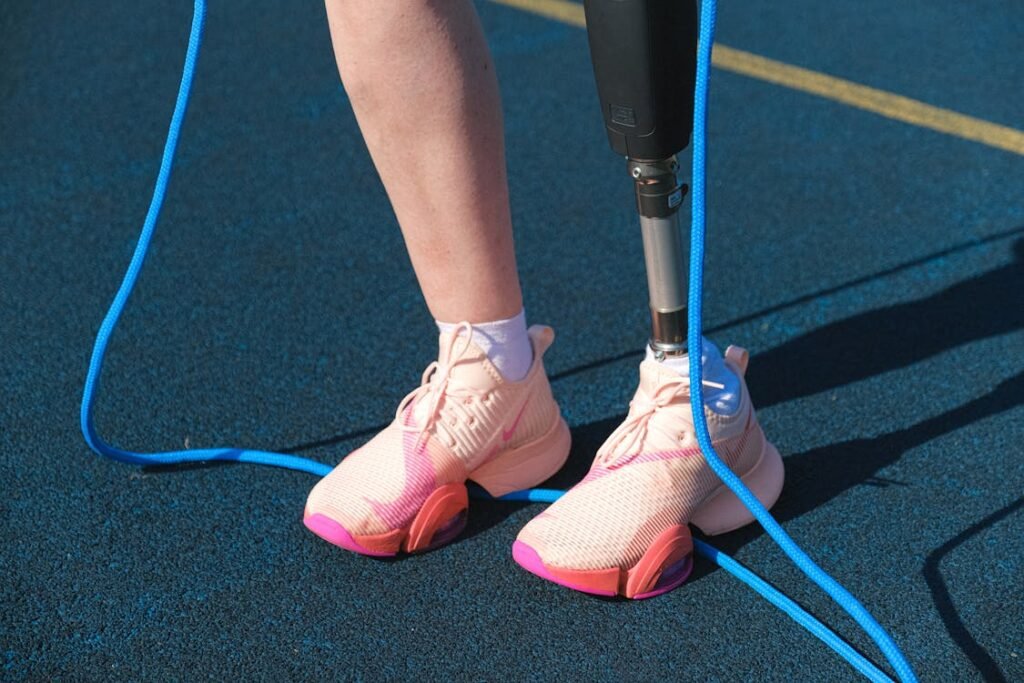
How Visual Feedback Improves Prosthetic Gait Correction
Seeing Your Movement Changes How You Move
When someone uses a prosthesis, especially for the first time, their walking often becomes more about thinking than feeling. They focus hard on each step. But without the right feedback, it’s difficult to know what needs fixing. That’s where visual feedback comes in. It makes walking less of a guess and more of a guided practice.
Seeing yourself walk — whether through a mirror, video, or live feedback on a screen — allows your brain to understand your movements better. You might notice that one step is shorter than the other, or that your prosthetic leg doesn’t lift as smoothly. These are things that you can’t always feel but can often see. That visual input helps your brain adjust your movement in real time.
Over time, this turns into habit. What you watch becomes what you do. Your brain remembers the corrections, and soon, you no longer need the visual reminder because your body starts to move the right way on its own.
This process is called motor relearning. It’s like teaching your brain a new dance — one where the prosthesis is no longer an outside object but a part of your movement pattern.
Video Feedback: A Powerful Tool for Self-Correction
While mirrors are useful, recorded video is another valuable tool in prosthetic gait correction. Watching a recording of yourself walking gives you the chance to study your movements without the pressure of acting in the moment. You can slow the video down, pause, rewind, and look closely at how each part of your body moves.
Many people are surprised the first time they see themselves walk on video. They notice things they never felt — like uneven hip movement, swinging the prosthesis out too wide, or leaning to one side. These visual cues help pinpoint exactly what needs to change.
The best part is, you can compare progress over time. By filming regular walking sessions, you start to build a record of your growth. You can actually see your strides becoming more even, your posture getting better, and your overall movement becoming more fluid.
For many users, these improvements boost more than just gait — they build confidence. You see your own strength on screen. You realize how far you’ve come. And that motivates you to keep going.
Video feedback also gives therapists a valuable teaching tool. Instead of simply describing what’s wrong, they can show you. That shared visual understanding speeds up the correction process and helps you work together more effectively.
Combining Mirrors and Movement for Best Results
Mirror therapy and visual feedback are not just about sitting still or watching passively. They work best when paired with active movement. Practicing weight shifts, stepping in place, and walking short distances while watching yourself in a mirror or video helps your brain and body sync together.
Simple routines — like shifting weight from one leg to the other, taking slow deliberate steps, or practicing toe-off and heel strike — become more effective when you can see what you’re doing. The mirror becomes your coach. The video becomes your teacher.
Even everyday movements, like climbing stairs or getting in and out of a chair, can benefit from visual feedback. Practicing these motions in front of a mirror or reviewing them on video helps you spot and fix problems before they become habits.
It’s not about being perfect. It’s about being aware. The more aware you are of how your body moves, the more control you gain. And with that control comes better balance, smoother motion, and less physical effort.

Incorporating Mirror Therapy Into Daily Gait Practice
Turning Routine Into Rehabilitation
One of the best things about mirror therapy is how easily it fits into everyday life. It doesn’t require a clinic, expensive equipment, or a full team of specialists. All you need is a mirror, a bit of space, and a few minutes a day. When practiced regularly, even short mirror sessions can make a real difference in how a person walks with a prosthesis.
The key is consistency. The brain learns best through repetition. Just five to ten minutes a day of focused mirror therapy can start to rewire the brain and improve motor control. These moments can become part of a daily routine — just like brushing your teeth or stretching in the morning.
It’s best to practice in a quiet space where distractions are low. A full-length mirror placed in front of a stable chair or open floor area can create the perfect setup. By watching yourself walk or perform movements while staying focused, you’re training both your mind and muscles to work in harmony.
Some users begin with basic movements like marching in place, standing up and sitting down, or stepping sideways. As their confidence grows, they move on to walking forward and backward slowly while keeping an eye on posture, alignment, and step rhythm in the mirror. This type of controlled practice builds better movement patterns from the ground up.
Guiding Children and Older Adults in Mirror-Based Training
Mirror therapy isn’t just for active adults. It’s also incredibly helpful for children and older adults who use prosthetics. For children, the mirror can become a fun and interactive tool — like a magic portal where they learn to move and play with their prosthesis. Guided games and playful movement routines make it feel less like therapy and more like a fun challenge.
For older adults, mirror therapy can rebuild confidence in walking after limb loss. Many older users develop fear after a fall or struggle with balance due to reduced muscle strength. Practicing in front of a mirror can calm those fears. It gives them the chance to walk slowly, see their movements, and make careful adjustments in a safe setting.
In both cases, the presence of a caregiver or therapist is helpful at first. Having someone gently point out alignment, posture, and balance shifts while using the mirror speeds up learning. Over time, many users grow confident enough to do the sessions on their own.
The point is not to push too hard. It’s to build awareness. When you can see what you’re doing right — and where you need support — your body learns to move smarter, not harder.
Tracking Improvement Through Visual Cues
One of the strongest benefits of using visual feedback and mirror therapy is that progress becomes visible. It’s not just a feeling — it’s something you can see. For many users, this becomes a source of motivation. Watching their reflection become steadier, smoother, and more symmetrical is a reminder that change is happening.
Many people use small visual markers to help track this progress. Taping lines on the floor, for example, helps monitor step width and stride length. Placing marks on the mirror can guide posture and shoulder alignment. These visual aids make it easier to notice small improvements, which often go unnoticed in regular walking.
Video diaries are also helpful. Recording short clips of walking practice every week or two allows users to compare how they move over time. This kind of visible progress strengthens commitment. It helps people stay focused on their goals, and it’s also incredibly encouraging to look back and see how far you’ve come.
For therapists, this progress tracking becomes a powerful tool for adjusting treatment plans. By analyzing changes in step rhythm, limb position, or upper body movement, they can offer more accurate advice and customize exercises based on real results.
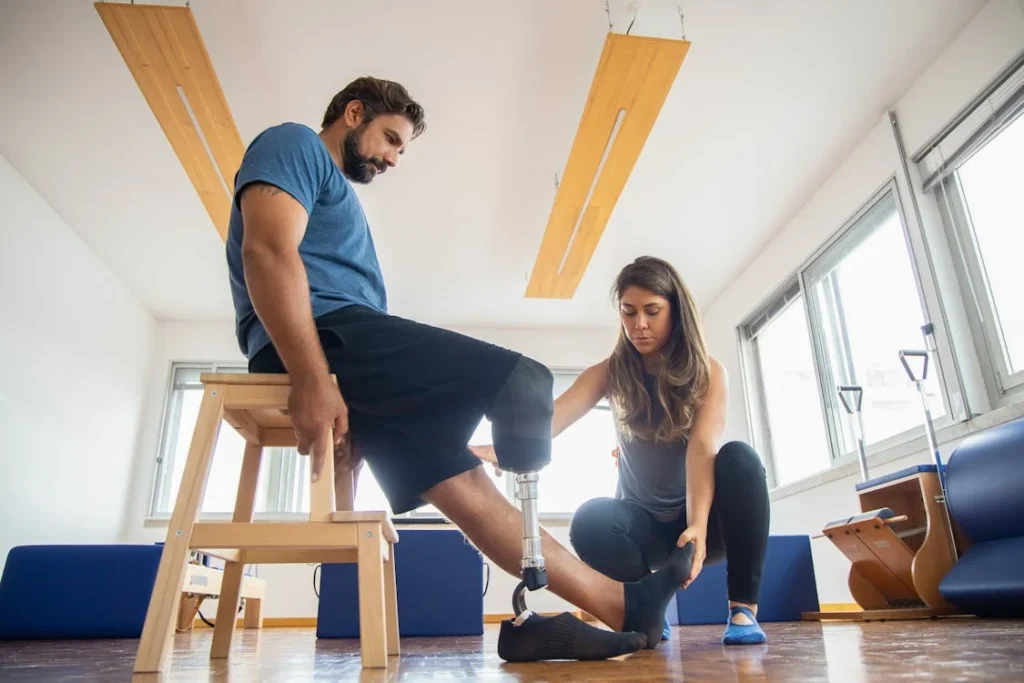
Overcoming Common Challenges in Mirror and Visual Gait Therapy
When the Brain Doesn’t Cooperate Right Away
While mirror therapy and visual feedback are powerful tools, they don’t always produce instant results. Sometimes the brain takes longer to respond, especially if the user has been walking with an improper gait for months or even years. At first, it may feel awkward to look in the mirror and see an uneven stride or unbalanced posture. For some, it might even feel discouraging.
This is a normal part of the process. The brain doesn’t relearn movement overnight. It needs time to rebuild trust in the body, especially when the limb it sees in the mirror isn’t a biological one. In those early sessions, the goal isn’t perfection — it’s patience. Progress starts with awareness. The first victory is noticing the problem. The next is trying to fix it.
It’s also important to keep in mind that visual feedback is only part of the puzzle. The brain also relies on touch, pressure, and balance signals to guide movement. If the residual limb is painful, if the socket doesn’t fit well, or if muscle strength is poor, the user may struggle to follow what they see in the mirror. That’s why mirror therapy works best when combined with regular prosthetic check-ups, physical therapy, and strength-building exercises.
Sticking with the practice, even for a few minutes a day, allows the brain to slowly adjust. Once the brain begins to accept what it sees as a real movement pattern, correction becomes easier, and gait starts to improve naturally.
Managing Frustration During the Learning Curve
For some users, especially those who are self-critical or goal-oriented, mirror therapy can feel emotionally challenging. Watching yourself walk with a limp or drag your prosthesis can stir up feelings of embarrassment, anger, or sadness. It’s easy to compare yourself to how you used to move or how others move, and feel like you’re not making enough progress.
This is where mental coaching becomes important. Users should be reminded that no movement is wrong — it’s just a starting point. The mirror isn’t judging you. It’s showing you where you are today so you can move forward tomorrow. Shifting the mindset from self-judgment to self-coaching helps users stay positive.
Frustration is a sign that you care. But progress comes from action, not from pressure. Taking breaks when needed, celebrating small improvements, and focusing on effort rather than outcome are ways to stay emotionally strong. Some users find it helpful to work with a therapist who understands both the physical and emotional sides of gait retraining. A supportive voice can make all the difference.
Adapting Visual Feedback for Limited Mobility or Vision
Not every user can stand in front of a mirror comfortably, especially if they have limited mobility, poor vision, or balance issues. In such cases, visual feedback can be adapted to suit the person’s needs.
For those with balance problems, seated mirror therapy can be an excellent start. Sitting upright while observing leg movement helps train muscle coordination and prepare the body for standing. Over time, users can move to supported standing exercises with a wall or walker for safety.
For users with low vision, high-contrast visual cues — like bright tape on the floor or large colored markers on the mirror — can make visual feedback easier to process. Sometimes, tactile feedback (like tapping or gentle touch) is used in combination to help reinforce what the eyes are trying to see.
Technology can also help. Some users benefit from using tablets or phones to record and review their movements up close. Others may use apps with slow-motion playback or voice prompts to support their practice.
The goal is always the same: help the brain understand what the body is doing, and guide it toward more balanced, confident movement. Whether that happens in front of a mirror, through a camera, or using simple tools — the method can be flexible. What matters most is that the user stays engaged and encouraged.
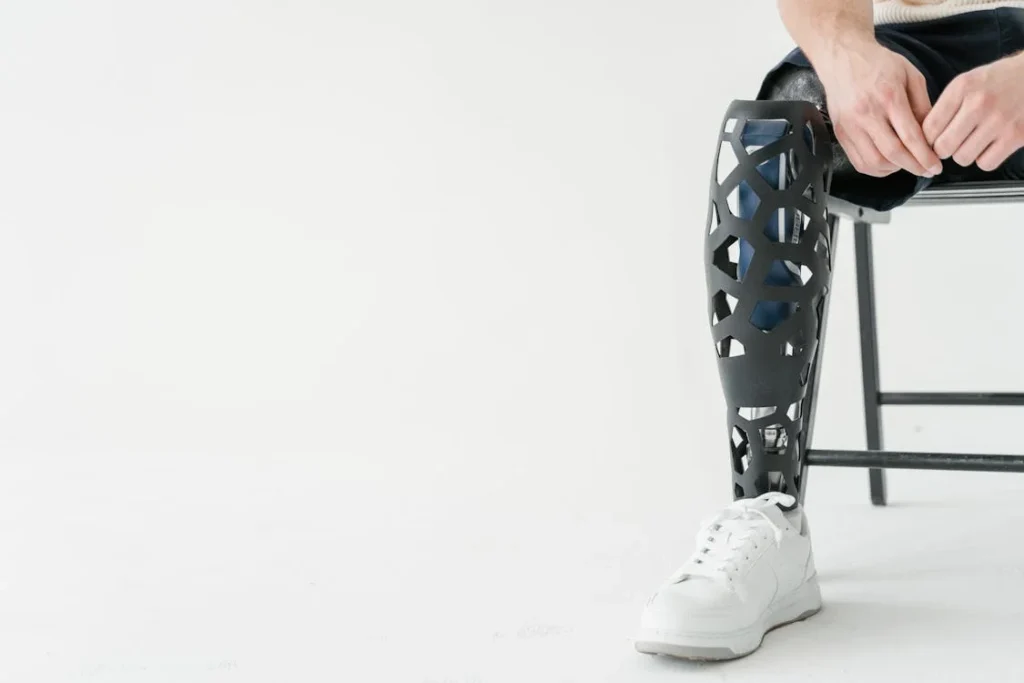
Mirror Therapy for Phantom Limb Pain: Healing Through Sight
What Phantom Limb Pain Really Feels Like
Many people who use a prosthetic leg experience sensations in the leg that’s no longer there. Some describe it as tingling. Others feel burning, itching, or even sharp, stabbing pain. This is known as phantom limb pain. It’s not imagined — it’s real, and it can be deeply uncomfortable or even disabling.
The brain, which once received signals from the missing limb, still tries to process those signals. But now, there’s no physical leg to send or receive feedback. This confusion causes the brain to misfire, creating pain or strange sensations in a limb that no longer exists.
While medications and therapies can help, many users are surprised to learn that mirror therapy — a method designed for movement correction — can also be a powerful tool for reducing phantom pain. And in some cases, it can stop the pain entirely.
How the Mirror “Tricks” the Brain Into Letting Go of Pain
Mirror therapy works on a powerful principle: what the brain sees, it believes. When a person places a mirror between their legs and moves the sound limb, the reflection gives the illusion that the missing limb is also moving. The brain, seeing both limbs moving in sync, is temporarily tricked into thinking the missing limb is still there — healthy, pain-free, and functional.
This illusion may seem simple, but it has a real, measurable effect on the nervous system. It helps reorganize how the brain processes movement and sensation. Over time, this reorganization reduces the false signals that cause phantom pain. The pain softens. In some cases, it fades completely.
Even users who have suffered from phantom pain for years often report significant relief after practicing regular mirror therapy. And unlike medication, mirror therapy has no side effects, no long-term risks, and no cost once the setup is in place.
Combining Gait Training and Pain Relief
One of the most remarkable things about mirror therapy is that it allows users to work on two goals at once: walking better and feeling better. As the brain begins to accept the prosthetic limb during mirror-based gait correction, it also starts to let go of the pain and discomfort linked to the missing limb.
This is why mirror therapy is often included in early rehabilitation. When introduced soon after amputation, it helps prevent the brain from forming those pain-causing patterns in the first place. But it’s just as effective later in recovery — even years after prosthesis use has begun.
For users struggling with both poor gait and phantom pain, mirror therapy becomes a unifying solution. It strengthens the mind-body connection, calms the nervous system, and creates a sense of wholeness that’s often lost after limb loss.
Many users find that once the phantom pain is reduced, their walking improves naturally. They no longer hold tension in their body. Their steps become more fluid. Their posture improves. And most importantly, their relationship with their prosthesis becomes less about limitation and more about freedom.
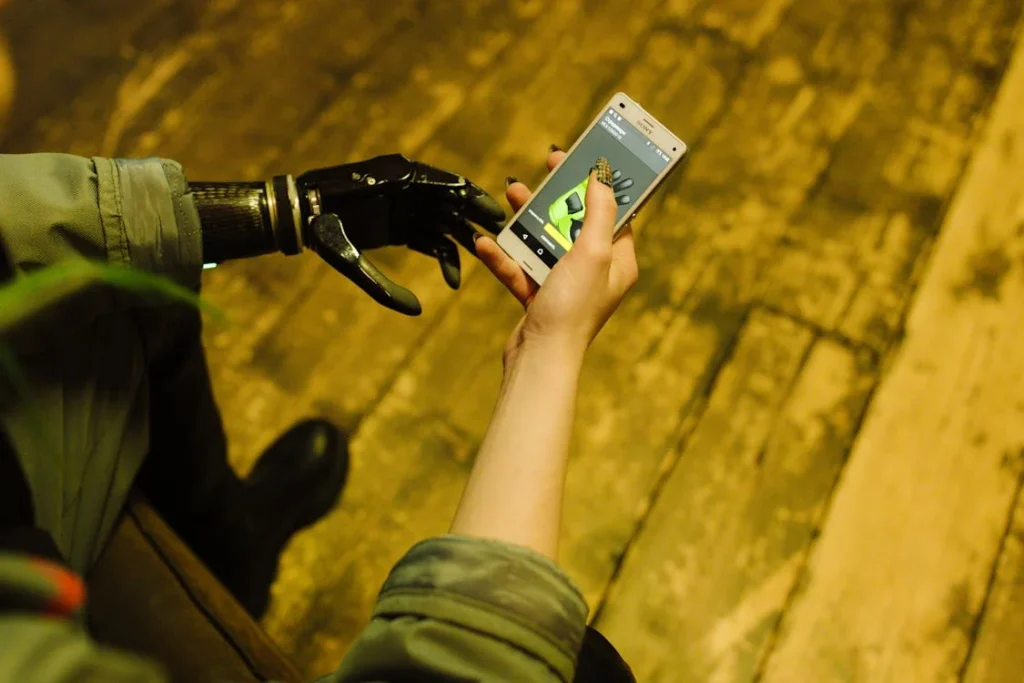
Technology Meets Therapy: Modern Visual Tools for Gait Correction
How Digital Tools Are Enhancing Mirror Therapy
Traditional mirror therapy uses a simple mirror and body movement — and it’s powerful. But as technology advances, new tools are taking the core idea of visual feedback and pushing it to new levels. These innovations are making gait correction smarter, more engaging, and in some cases, even enjoyable.
Digital mirror systems — often used in advanced rehabilitation centers — combine full-length screens with motion sensors and real-time video. These systems track the user’s movements and provide instant visual feedback on things like step length, joint angles, and balance. Unlike a simple mirror, these tools can show you exactly how your movement compares to an ideal walking pattern.
This immediate, data-backed feedback helps users correct mistakes quickly. It also gives therapists precise information to personalize training programs. And for users who are motivated by progress, these systems often include visual “games” or challenges, turning practice into a more interactive experience.
This is especially helpful for younger users or those who struggle to stay engaged with repetitive movement. The gamification of gait training — even something as simple as hitting visual targets on a screen while walking — can boost motivation, increase practice time, and improve outcomes.
Smartphone Video and Augmented Reality: Gait Tools in Your Pocket
Not every user has access to high-end clinical systems — but the rise of smartphones and tablets means that advanced visual feedback is more accessible than ever. A basic phone camera can now record, slow down, and analyze walking patterns with surprising accuracy. There are even mobile apps designed specifically for gait analysis, many of which are free or low-cost.
These apps allow users to record their walking from multiple angles, track progress over time, and even get guided correction tips based on the way their body moves. Some let you draw reference lines on screen to measure step length or limb alignment. Others offer slow-motion playback so you can catch subtle imbalances that are hard to see in real time.
A few emerging tools are using augmented reality (AR) — placing digital overlays on live camera feeds. Imagine pointing your phone at yourself while walking, and seeing virtual lines showing your limb angles or balance path. This kind of visual coaching in real time can take home-based therapy to the next level.
Even virtual reality (VR) is beginning to enter the rehab world. In VR environments, users practice walking in simulated spaces, reacting to visual challenges like obstacles or moving surfaces. While still in early use, this approach offers exciting potential for training gait in a safe, engaging, and highly adaptive way.
Empowering Users With Data and Control
What all these technologies have in common is that they give users more information, more feedback, and more control. And that’s powerful. When you can see what’s working and what’s not — not just feel it — you become an active partner in your recovery. You move with intention. You learn faster. You gain confidence.
These tools also allow for better communication between users and professionals. If a user records a video at home and sends it to their therapist, it opens up a whole new level of remote support. Adjustments can be made between clinic visits. Progress can be tracked even across distances. This is especially important in a country like India, where access to consistent rehabilitation services can be limited by geography.
Most importantly, these digital tools help make therapy personal. Whether it’s a mirror in the living room or a motion-tracking app on your phone, visual feedback becomes part of your everyday life — not just something you do at the hospital. That’s how habits form. That’s how lasting change happens.
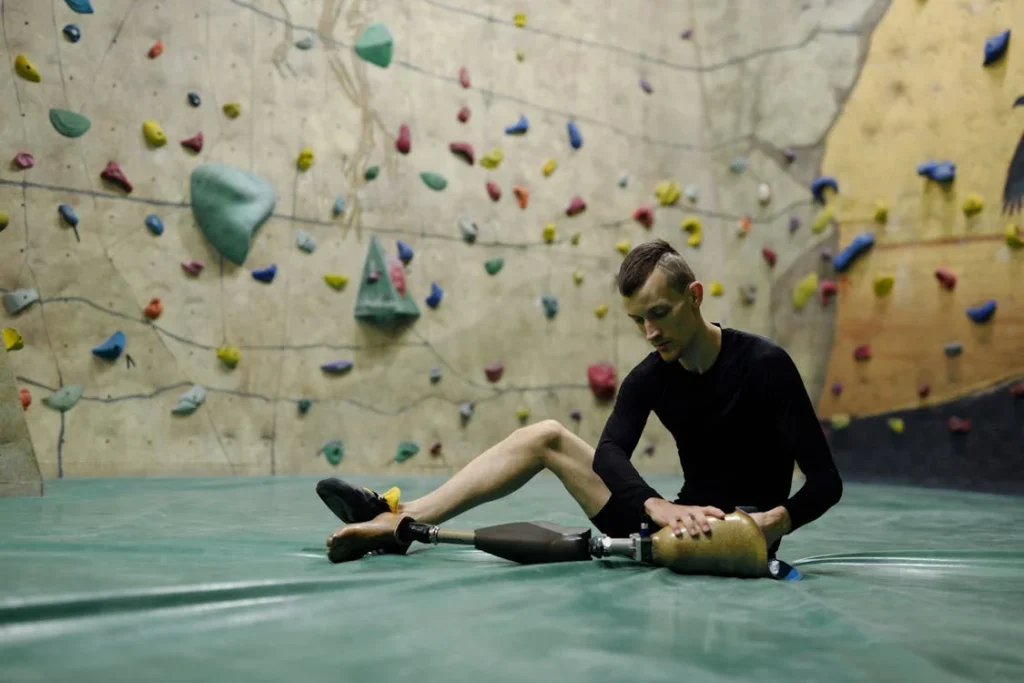
Reclaiming Body Awareness: Visual Therapy as a Path to Self-Acceptance
How Limb Loss Affects Self-Perception
Losing a limb doesn’t just change how you move — it changes how you see yourself. Many prosthetic users struggle with body image, especially in the early stages of recovery. They may feel disconnected from their own reflection. The prosthetic limb can feel foreign, unfamiliar, or even like something to hide. This emotional distance can quietly slow down physical progress, because how we feel about our body directly affects how we use it.
For some, this discomfort leads to avoiding mirrors altogether. They may not want to watch themselves walk, or even stand still in front of their reflection. This avoidance makes it harder to build trust with the prosthetic limb — and harder to accept the new version of themselves.
That’s where mirror therapy steps in as more than just a tool for movement correction. It becomes a way to gently rebuild self-image. To look, accept, and eventually embrace the body again — including the prosthesis.
Seeing the Prosthesis as Part of the Body, Not Separate From It
In mirror-based gait work, the user doesn’t just observe motion — they start to notice form. The shape of the body. The alignment of the legs. The way the prosthetic side and natural side move together. Over time, the prosthesis begins to feel less like a machine and more like a real part of the whole.
This shift is powerful. It transforms the prosthesis from an object into an extension of the self. And when this mental shift happens, users often report not just better gait — but better posture, stronger presence, and a greater sense of ownership over their movement.
Visual therapy allows the brain to redraw its internal map of the body — a map that might have been damaged or erased after amputation. By watching the body move in the mirror and on video, the user creates a new mental blueprint. One that includes the prosthetic leg not as a substitute, but as the leg. This deep internal change boosts confidence and smooths the recovery journey.
Supporting Emotional Healing Through Visual Affirmation
Emotional healing doesn’t always come from words. Sometimes it comes from quietly watching yourself succeed — taking a smooth step, standing upright, or seeing the reflection of balance where there once was struggle. These moments of visual affirmation can be subtle, but they are deeply healing.
They tell the brain: “This is me. And I am okay. I am whole. I am walking.”
Therapists can support this by guiding users to approach the mirror without judgment. By encouraging small acknowledgements — “That was a strong step” or “I stood straighter today” — they help replace negative self-talk with realistic self-celebration.
Over time, users begin to accept — and even take pride in — their new body. This self-acceptance becomes the foundation for every other part of their journey, from social interactions to personal independence.
Because walking well isn’t just about muscles and joints. It’s about feeling confident enough to move forward without fear. And that kind of confidence often begins with a single brave look in the mirror.
Conclusion
Walking with a prosthetic leg is more than a physical task — it’s a full-body, full-mind experience. Mirror therapy and visual feedback offer something rare: a way to reconnect the brain, body, and prosthesis in a clear, simple, and deeply human way. They help users see their own progress, correct their gait in real time, and slowly rebuild confidence from the inside out.
These tools go beyond movement. They ease phantom pain, improve balance, support emotional healing, and reshape self-image. Whether it’s a simple mirror in the living room or a smart app on a phone, visual feedback empowers users to move with awareness — not fear.
At Robobionics, we believe rehabilitation should be personal, practical, and empowering. Mirror therapy proves that powerful change can come from simple tools — and that progress begins with seeing yourself not as broken, but as whole, evolving, and strong.
Every step matters. And sometimes, the first one is simply looking in the mirror — and saying, “I can do this.”



